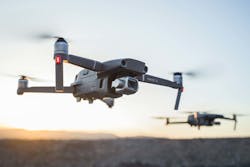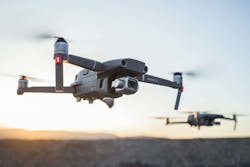Drones are the next chapter in Chinese economic warfare
Unmanned aviation systems (UASs) — drones — have come to business. But we ain’t seen nothing yet. Multiple forecasts project enormous compound annual growth rates for commercial UASs of up to 60%. Most spending to date has targeted uses such as deliveries, site inspections, land surveying, photography, energy exploration, and terrain mapping.
Organizations now increasingly realize that UASs can benefit security and related areas such as safety, compliance, and audit. These applications are legion: surveillance, guard services, data collection, counterespionage, loss prevention, event monitoring, incident response, perimeter protection, and investigations, among an endless list of applications.
As companies pour money into drones, they should be wary of where their investment is going. More than three-quarters of the U.S. drone market, including both private and public customers, is controlled by a single Chinese supplier. And that supplier is essentially an arm of the Chinese government--the same government that has been orchestrating the systematic siphoning of American intellectual property to the tune of an estimated $300 billion to $600 billion per year.
Chinese Manufacturer DJI is Suspect
A 2022 joint investigation by The Washington Post and IPVM, a video surveillance research firm, found that the drone maker, DJI, “obscured its Chinese government funding while claiming that Beijing had not invested in the firm.” China is well known for having national companies do its bidding. In fact, Article 7 of China’s National Intelligence Law codifies this relationship: “Any organization or citizen shall support, assist and cooperate with state intelligence work in accordance with the law, and maintain the secrecy of all knowledge of state intelligence work.”
Moreover, the drone software can be exploited. German researchers recently disclosed that they found 16 distinct vulnerabilities in DJI software. Fourteen of the bugs could be triggered remotely over a smartphone—including forcing a drone to crash.The U.S. government has long recognized Beijing’s economic and military threat. More specifically, it has acted on the drone threat multiple times. The U.S. Army banned DJI drones in 2017 due to cybersecurity concerns. The Departments of Commerce, Justice, and the Interior followed suit three years later while targeting foreign-made drones and their espionage and cyber threat potential more generally. In 2019, DHS’s Cybersecurity and Infrastructure Security Agency warned that DJI posed risks in their data collection, transmission, storage, and security. Congress has banned the U.S. military from using Chinese drones, and DoD placed DJI on a list that prohibits U.S. exports to the country, based on DJI’s contribution to Beijing’s abuse of the Uyghurs.
DoD Takes Step to Curb DJI Influence
In late 2022, President Biden signed into law an amendment of Section 817 of the National Defense Authorization Act that prevents the DoD from contracting with DJI. On April 26, 2023, two members of Congress introduced the Countering CCP Drones Act, which would prohibit DJI from using the U.S. telecommunications infrastructure.
Many police agencies fly DJI drones over our cities, exposing critical infrastructure such as bridges, ports, electrical substations, reservoirs, and hospitals to their sensing and mapping capabilities. They do so because they are cheap—subsidized by Beijing—and help their under-resourced agencies serve the public while reducing officer injuries. Good intentions and justifications on behalf of law enforcement notwithstanding, state legislatures are pushing back. Florida, Arkansas, and Mississippi recently banned drones from countries of concern, including China. Similar legislation is on the table in states including Tennessee and Alabama.
When U.S. companies use drones from China — or any hostile nation — they risk not just economic espionage but also threaten our national security. Loaded with cameras, thermal imaging, and numerous other sensors, drones are the proverbial foxes in the henhouse if foxes could fly and map terrain and infrastructure.
Hostile Foreign Regimes Pose Drone Threats
In fact, UASs can be considered just one more tool used by hostile regimes for economic depredation and cyberwarfare. In May 2022, Cybereason exposed so-called Operation CuckooBees, in which the notorious Chinese hacker group tied to Beijing’s Ministry of State Security, known as APT 41, was found to have stolen potentially trillions of dollars of intellectual property from manufacturing, energy, and pharmaceutical companies. The operation scooped up the likes of blueprints of fighter jets, formulas for new diabetes drugs, and details about proprietary network architectures.
The FBI has long considered China to be the biggest law enforcement threat to the United States. In 2020, FBI Director Christopher Wray said that the Bureau had “about 1,000 investigations involving China’s attempted theft of U.S.-based technology, in all 56 of our field offices and spanning just about every industry sector.”
China’s vast reach into the technology marketplace creates a significant operational security concern for U.S. companies, especially defense contractors and those engaged with innovative technology. In addition to drones, Chinese manufacturers are heavily rooted in video surveillance cameras and components that proliferate in Western companies. Sensitive video surveillance information may be jumping the company fence line on its way to Beijing, a risk raised by the defense industrial base several years ago. The risk does not stop with companies. Many of the components found in smart homes, appliances, and originate in China and pose a similar beaconing capability, where an individual’s personal habits or routines can be surreptitiously captured and stored.
Similar to the espionage threat posed by other security manufacturers tied to hostile regimes, corporate security professionals, consultants, specifiers, and others in the industry should consider the source of their drone systems carefully. In fact, American companies can take a leadership role, through their security departments, by setting an example for our public sector counterparts. Such an example might also encourage Congress to fund a mandate to replace Chinese drones with those made in the United States or by our allies.
About the authors:
About the Author

Dave Komendat
President of DSKomendat Risk Management Services
Dave Komendat is the President of DSKomendat Risk Management Services. In this role Dave serves on the advisory board for several companies consulting on strategic security issues and concerns. Previously, Dave was the long-tenured Vice President & Chief Security Officer for the Boeing Company, the world’s largest integrated aerospace company. Dave also serves as a Strategic Engagement Advisor for the FBI’s Office of The Private Sector.

Michael Gips, JD, CPP, CSyP, CAE
Contributing writer at Swiftlane
Michael Gips, JD, CPP, CSyP, CAE has written almost 1,000 articles and columns on virtually every topic in security. He is currently the Managing Director of ESRM for Kroll and the principal of Global Insights in Professional Security, LLC. This firm helps security providers develop cutting-edge content, assert thought leadership, and heighten brand awareness in a crowded marketplace. He has been repeatedly named as one of the most influential thought leaders in private security. He recently joined the Board of Advisors of Draganfly.
Gips is an occasional contributor to SecurityInfoWatch.com and Security Executive magazine.



